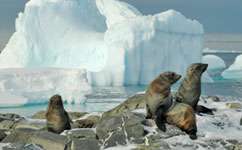Antarctic fur seals breed where they were born

Scientists have discovered that female Antarctic fur seals have an uncanny ability to return to within a body length of where they were born when it's time to breed.
Even if they don't manage to get this close, the majority of females give birth to pups within 12 metres of where they themselves were born.
"It's as if they have some sort of in-built GPS system," says Dr. Joe Hoffman from the University of Bielefeld in Germany, who led the study. "Or it could be simply that they're using cues, like smell, that we can't measure. What is remarkable is that the colony is featureless, so it's impressive they find their way back."
What's also striking is that these seals may have spent up to five years feeding hundreds of kilometres out at sea before coming home.
Knowing more about how these seals live their lives will help scientists understand how populations affect the fragile local ecosystem of South Georgia in the south Atlantic Ocean.
Around 97 per cent of the world's Antarctic fur seal population lives in South Georgia. Hunted to near-extinction in the late 1800s and early 1900s, the population has bounced back from a mere 30 individuals to millions of seals today.
But with anywhere between three and five million seals coming ashore to breed each year, scientists are discovering that they're eroding grasses and may be damaging rare plants.
"We're also interested in finding out how variations in the climate affect these seals. They rely on krill, which in turn are affected by weather systems like El Nino," says Hoffman.
Previous studies have revealed that marine animals like seals, sea lions and walruses tend to return to their birth colonies to breed. In one study, scientists found that female grey seals at North Rona and the Isle of May in Scotland chose pupping sites within 100 metres of where they were born.
And only a few years ago, Hoffman and colleagues also discovered that once the seals have found a place to have their pups, they're remarkably faithful to it, returning within a few metres of breeding sites they'd used in previous years.
"If both males and females return to the same spots year after year, this could create stable neighbourhoods and may limit conflict in the colony," explains Hoffman.
But whether females return to their birth sites to breed was unclear until now.
To find out, Hoffman and Dr. Jaume Forcada from the British Antarctic Survey (BAS) analysed the movements of seals on a cobblestone beach about half the size of of a football pitch on Bird Island in South Georgia. The colony here is dense: about 600 females and up to 200 males typically vie for space.
To do this, the researchers tagged 335 female seals soon after they were born, at the same time recording exactly where they were born. The tags they used are similar to the ones vets use on domestic cats and dogs.
A month later, they also fitted plastic tags onto the seals' flippers to make identification easier.
A few years later, the scientists managed to track down 38 of the 335 females they'd tagged. The researchers used an elevated scaffold walkway built by BAS scientists several decades ago to record the seals' movements. The walkway lets researchers accurately record the locations of individual seals to the nearest metre with minimal disturbance.
As well as finding that females prefer to breed exactly where they were born, Hoffman and Forcada found that as mothers got more experienced, the distance between breeding site and where there were born dropped.
"As females get more experienced, they're more able to get back to their birth location," says Hoffman.
Having established this ability, Hoffman says one of the next things to find out is how on Earth they manage it.
The study is published in Mammalian Biology.
This story is republished courtesy of Planet Earth online, a free, companion website to the award-winning magazine Planet Earth published and funded by the Natural Environment Research Council (NERC).
More information: Joseph Ivan Hoffman, Jaume Forcada, Extreme natal philopatry in female Antarctic fur seals (Arctocephalus gazella), Mammalian Biology, published online 13 October 2011, doi:10.1016/j.mambio.2011.09.002
Provided by PlanetEarth Online



















